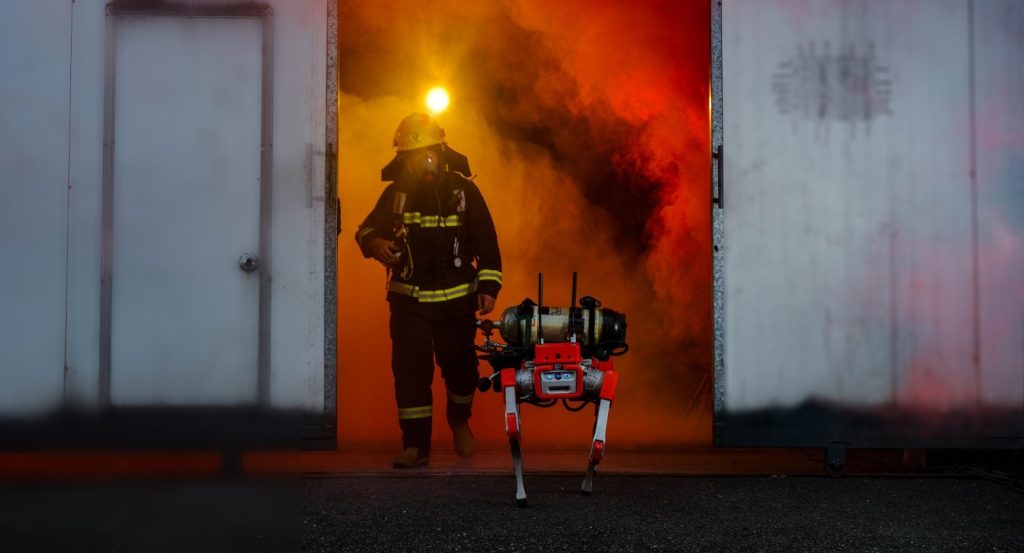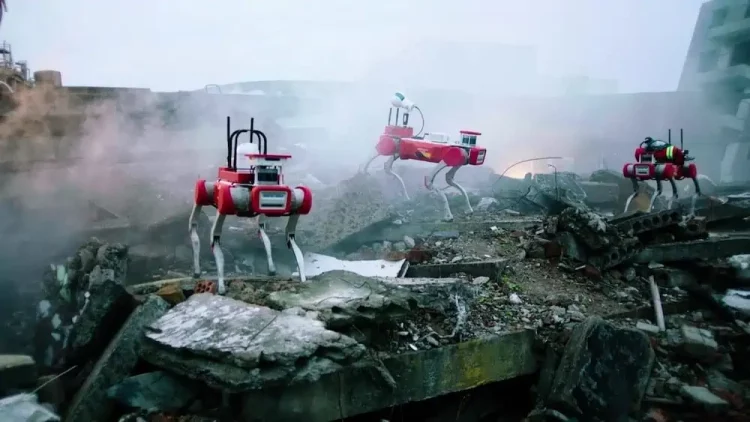1. Introduction: The Need for Advanced Robotics in Search and Rescue Operations
In disaster-stricken areas, particularly in collapsed buildings, earthquake zones, and wrecked infrastructures, human rescue teams often face immense challenges due to debris, unstable structures, and hazardous conditions. Traditional search and rescue methods, involving human teams and basic tools, are limited by time, risk factors, and the physical nature of the environment.
Quadruped robots, designed to mimic the agility and mobility of animals, have emerged as a promising solution. Unlike wheeled robots, which may struggle to navigate rough, uneven terrain, or drones, which are limited in confined spaces, quadruped robots combine strength, flexibility, and precision to maneuver through challenging environments. They are designed to function in a variety of terrains, making them particularly suited for rescue operations in ruins and other difficult environments.
The ability of quadruped robots to carry sensors, cameras, and even medical supplies while navigating through tight spaces enables them to complement human rescuers. Their potential is not only in their physical mobility but also in their ability to make decisions and work in real-time, collecting vital information that can save lives.
2. Technological Foundations of Quadruped Robots
2.1 Design and Mobility
Quadruped robots are built to mimic the locomotion of animals like dogs or goats. They feature four legs, each equipped with joints and actuators that allow for flexible movement. The design incorporates dynamic stability and balance control, ensuring that the robot can adjust its posture to adapt to its environment. This makes them highly capable of walking on uneven ground, climbing stairs, navigating rubble, and even scaling obstacles.
The most notable advantage of quadruped robots is their ability to overcome complex obstacles without the need for human intervention. Unlike traditional wheeled robots, quadruped designs excel in rough terrain, such as the remains of collapsed buildings, areas with scattered debris, and other rugged landscapes.
2.2 Sensors and Perception Systems
Quadruped robots are equipped with various sensors to perceive and interact with their environment. These include LiDAR, cameras, infrared sensors, sonar, and gas detectors. LiDAR sensors, for instance, generate detailed 3D maps of the terrain, helping robots navigate and plan their path. Thermal imaging cameras allow them to detect heat signatures, which is crucial for locating survivors or sources of fire.
Additionally, ultrasonic sensors can help detect the presence of objects or individuals in tight spaces by bouncing sound waves off nearby surfaces. This sensor suite enables quadruped robots to make real-time decisions based on environmental feedback, improving the accuracy and efficiency of their missions.
2.3 Artificial Intelligence and Machine Learning
Autonomous navigation in disaster zones requires robust decision-making capabilities. Quadruped robots rely on AI algorithms and machine learning to analyze data from sensors, adapt to new environments, and make real-time decisions. These algorithms process sensor inputs to identify obstacles, detect anomalies, and adjust movement strategies, allowing robots to work independently in hazardous conditions.
For example, when encountering an obstacle such as a collapsed wall or uneven rubble, the robot’s AI system will evaluate the situation and choose the most efficient way to navigate around or over it, reducing the risk of damaging critical infrastructure or putting rescuers in danger.
2.4 Communication Systems
In disaster environments, maintaining communication between the robot and its human operators is essential. Wireless communication systems, including 5G, Wi-Fi, and satellite communication, enable the robot to transmit real-time data, such as images, video feeds, and sensor readings. This allows rescuers to gain critical insights into the situation, such as the presence of survivors or structural integrity, without physically entering dangerous zones.

3. Applications of Quadruped Robots in Search and Rescue
3.1 Urban Disaster Recovery
In the aftermath of natural disasters such as earthquakes, building collapses, or tornadoes, quadruped robots can be deployed to search through rubble piles, inspect damaged buildings, and provide real-time data to rescue teams. They are particularly useful in urban environments where human rescuers might be at risk of further structural collapse.
For example, Spot, a quadruped robot developed by Boston Dynamics, has been tested in disaster recovery operations. Spot’s ability to traverse staircases and maneuver around obstacles makes it an ideal tool for scouting collapsed buildings, searching for trapped individuals, and mapping the terrain.
3.2 Hazardous Material Detection and Chemical Spills
Quadruped robots can also be equipped with specialized sensors to detect hazardous materials such as gas leaks, chemical spills, or radiation. Their autonomous nature allows them to enter hazardous areas and gather critical data without putting human workers in danger.
For instance, during a chemical leak or nuclear accident, quadruped robots could navigate through contaminated environments, providing real-time sensor readings to authorities and helping identify safe pathways for human responders.
3.3 Rescue Operations in Remote or Confined Spaces
Another significant application of quadruped robots is in rescue operations in remote or confined spaces, such as cave rescues or mining accidents. These robots are capable of navigating narrow tunnels, uneven ground, and other challenging terrains that are often inaccessible to human rescue teams. Their compact design allows them to move through tight spaces, delivering supplies, communicating with trapped individuals, and providing essential situational awareness.
In the event of a mine collapse, quadruped robots equipped with cameras and infrared sensors can search for trapped miners, identifying potential victims by their heat signatures, and relay information to human rescuers about the location of survivors.
3.4 Real-Time Data and Situation Awareness
Quadruped robots can be deployed in search missions to gather critical information that aids in decision-making. Equipped with high-definition cameras, thermal imaging systems, and environmental sensors, these robots can collect visual data, temperature readings, and atmospheric conditions, providing a comprehensive overview of the disaster scene. By sending live data to the command center, they help rescuers assess the situation and plan the most effective response strategies.
4. Advantages of Using Quadruped Robots for Search and Rescue
4.1 Enhanced Mobility in Rough Terrain
One of the most significant advantages of quadruped robots is their exceptional mobility. They can easily maneuver through rough terrain, debris, and confined spaces, areas that would be extremely difficult or dangerous for human rescuers. Their four-legged design allows them to maintain balance and stability, even when navigating difficult surfaces like rubble, rubble piles, and narrow pathways.
4.2 Reduced Risk to Human Lives
Quadruped robots minimize the risk to human lives by entering hazardous areas on behalf of human rescuers. These robots can perform critical tasks such as searching for survivors, detecting hazards, and assessing the structural integrity of buildings without putting human responders in harm’s way.
4.3 Autonomous Decision Making
With advancements in artificial intelligence and machine learning, quadruped robots can operate autonomously in disaster zones. This allows them to work independently of human operators for extended periods, navigating through dangerous areas, conducting searches, and delivering vital data.
4.4 Cost-Effectiveness and Time Efficiency
Deploying quadruped robots can save both time and money in disaster recovery operations. Their ability to autonomously search and navigate through debris significantly reduces the time it takes for human teams to assess a disaster zone and locate survivors. In turn, this speeds up rescue efforts and can potentially save more lives in a shorter timeframe.
5. Challenges and Limitations
5.1 Power and Battery Life
One of the primary challenges faced by quadruped robots is their limited battery life. In disaster environments, where charging infrastructure may be scarce, maintaining power to these robots can be a challenge. Most robots rely on lithium-ion batteries, which may only last a few hours under heavy load. Energy-efficient designs, solar-powered solutions, and portable charging stations are some potential solutions to this issue.
5.2 Terrain and Environmental Conditions
Although quadruped robots are highly versatile, certain terrains or weather conditions can still hinder their performance. For example, extremely muddy or icy environments may present mobility challenges, and extreme weather conditions such as heavy rain or snow could interfere with the robot’s sensors and communication systems.
5.3 Ethical and Privacy Concerns
The use of robots in search and rescue operations raises potential privacy concerns. As these robots often rely on cameras and sensors to gather real-time data, it is crucial to ensure that the information they collect is handled responsibly and ethically, particularly when the data involves private individuals or sensitive environments.
6. Future Potential and Innovations
As robotics technology continues to evolve, the potential applications of quadruped robots in disaster recovery and search and rescue operations are vast. Future innovations may focus on improving autonomy, battery life, and sensor capabilities. Additionally, integrating AI-powered decision-making systems will enhance the robot’s ability to make real-time decisions, increasing their efficiency and effectiveness in critical situations.
Moreover, collaborations between robotics companies, emergency response teams, and governments will help ensure that quadruped robots are seamlessly integrated into disaster recovery plans, helping to save lives and reduce the impact of natural and man-made disasters.
7. Conclusion
Quadruped robots represent a breakthrough in robotics technology, offering unparalleled mobility, flexibility, and independence for search and rescue operations in ruins and disaster-stricken areas. By leveraging advanced sensors, artificial intelligence, and cutting-edge design principles, these robots are poised to transform the way we respond to emergencies, ultimately making rescue operations faster, safer, and more efficient.
While challenges remain in terms of battery life, terrain adaptation, and ethical concerns, the rapid pace of innovation ensures that quadruped robots will continue to improve, becoming an indispensable tool for first responders. As technology evolves, these robots will not only enhance disaster recovery but also redefine the future of search and rescue missions.







































